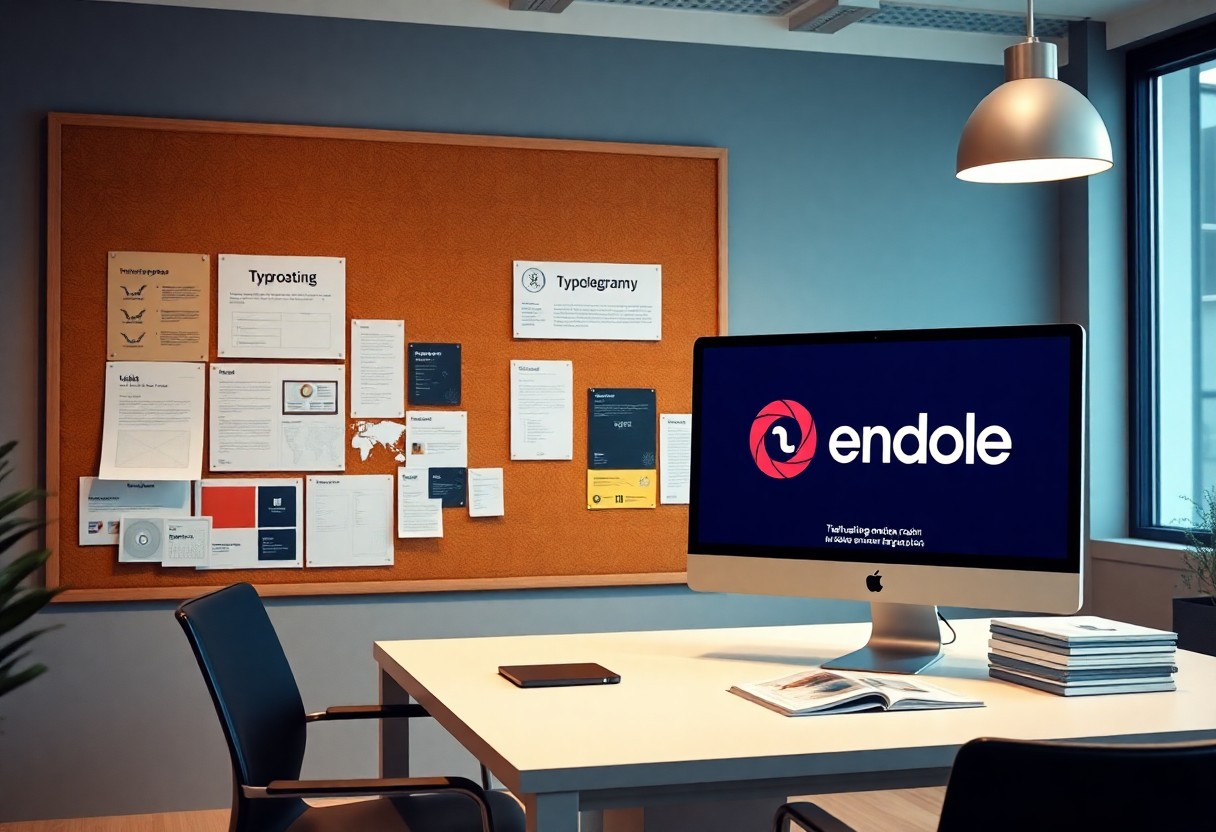Just as every great story needs a captivating plot, your brand requires a cohesive identity that blends graphic design and content writing seamlessly. Understanding how these two elements work together can elevate your brand’s presence and engagement. In this blog post, you will explore the important strategies for aligning your visuals and messaging, ensuring that your audience recognizes and connects with your brand on a deeper level. Dive into the intersection of design and words, and unlock the potential for a memorable and impactful brand identity.
Aesthetic Language: The Power of Visual Storytelling
Visual storytelling creates an emotional connection between your brand and your audience. By skillfully combining imagery, colors, and typography, you can convey your brand’s narrative in a way that resonates deeply. This synergy between graphic design and content writing shapes the viewer’s perception, guiding them through an immersive experience that aligns with your brand values and messaging.
The Psychology of Color and Design
Color choice significantly influences how your audience perceives your brand. For instance, blue often evokes feelings of trust and dependability, while red can incite excitement and passion. Understanding color psychology allows you to craft a visual identity that speaks to your target audience, ensuring that your design choices embody the emotions and ideals you want associated with your brand.
Font Choices and Brand Perception
Your selection of fonts communicates much more than mere readability; it conveys personality and sets the tone for your message. A serif font might suggest tradition and reliability, while a sans-serif may express modernity and approachability. An example is The New York Times, which employs a classic serif font that evokes authority and trust in journalism. Font choices, therefore, play a pivotal role in shaping how your audience perceives your brand’s identity.
When you choose fonts, consistency across mediums matters more than you might realize. Typography consistency reinforces brand identity, making it instantly recognizable. For example, renowned brands like Coca-Cola use a specific script font that remains unchanged across platforms. This commitment to a cohesive font choice strengthens their brand recognition and trust. By strategically selecting fonts that reflect your brand personality, you’ll not only enhance user experience but also substantiate the emotions you wish to evoke in your audience.
Crafting Consistent Brand Messaging
Consistency in brand messaging not only reinforces your identity but builds trust with your audience. You’ll want to ensure that every piece of content—whether it’s a social media post or a blog entry—delivers a unified message that echoes your brand’s mission, vision, and values. This cohesion influences how consumers perceive your brand and creates stronger recognition over time. Regularly revisiting your core messages can keep your communication aligned and focused.
The Role of Tone and Voice
Your brand’s tone and voice are integral to delivering consistent messaging. These elements should speak directly to your target audience, creating familiarity and relatability. For instance, a youthful, casual tone might resonate well with a younger demographic, while a more formal voice could appeal to a corporate audience. Tailoring your tone not only reflects your brand’s personality but also enhances emotional engagement with your audience.
Integrating Brand Values into Content
Embedding your core brand values into every piece of content can significantly impact how your audience connects with your brand. By illustrating values through storytelling, you provide context that resonates deeply. For example, if sustainability is a key brand value, showcasing eco-friendly practices in your content not only builds credibility but aligns your messaging with what you stand for. This alignment fosters loyalty among consumers who share your values.
Integrating brand values transcends mere words; it’s about translating those principles into actionable content. Let’s say your brand prioritizes community engagement. You could share stories of local initiatives or volunteer efforts, which showcase your commitment and invite your audience to be part of a larger cause. Such content not only amplifies your message but enables a two-way conversation, further solidifying the connection between your brand and your audience. Over time, this strengthens trust and can create passionate advocates for your brand who not only consume your content but actively participate in your mission.

Aligning Graphic Design with Marketing Goals
Effective brand messaging hinges on the seamless alignment of graphic design with your marketing objectives. A well-crafted design strategy enhances your overarching goals by ensuring that visuals not only attract attention but also resonate with your target audience. For instance, if your goal is to boost brand awareness, a distinctive logo that stands out in crowded spaces can significantly enhance recognition. Establishing continuity in color palettes and typography across all marketing channels reinforces this alignment, prospectively increasing conversion rates as customers develop familiarity and trust in your brand.
How Visuals Enhance Consumer Engagement
Visuals play a pivotal role in engaging consumers by quickly conveying messages that words alone may not fully express. Use of infographics can simplify complex information, ensuring your audience not only retains key takeaways but also finds your content more appealing. Data shows that visuals can increase user interaction by up to 94%, making your marketing strategies significantly more effective.
Building Trust Through Cohesive Design
Your brand’s visual identity directly influences consumer perceptions. Consistency in design elements—like colors, fonts, and imagery—across all platforms builds a sense of reliability and professionalism. Research indicates that cohesive branding can increase revenue by up to 23%. By ensuring all customer touchpoints—websites, social media, packaging—reflect the same design elements, you create a unified brand experience that fosters trust and encourages customer loyalty.
Consider brands like Coca-Cola, whose signature red and consistent font evoke instant recognition and familiarity. This coherent visual identity not only distinguishes the product in a crowded market but also reinforces customer loyalty over time. Your cohesive design needs to articulate who you are at every interaction, allowing consumers to connect emotionally and intellectually. Investing in professional graphic design that aligns with your brand principles and messaging will transform your strategy and strengthen consumer trust.
Collaborative Strategies for Designers and Writers
Successful collaboration between designers and writers fosters a unified brand identity that resonates with your audience. Establishing shared goals and understanding each other’s processes can enhance communication and improve project outcomes. Regular check-ins and brainstorming sessions create an environment where creativity flourishes, allowing both parties to contribute their strengths. Shared feedback loops enable you to refine your work collaboratively, ensuring that both visuals and copy effectively convey your brand’s message.
Creating Effective Communication Channels
Utilizing collaborative tools such as Slack or Trello facilitates ongoing dialogue between designers and writers. Setting up dedicated channels for instant feedback and updates ensures both teams are aligned throughout the creative process. Regular meetings to discuss projects can further support clarity, allowing you to address challenges and celebrate successes together, ultimately boosting efficiency and fostering a strong partnership.
Tools and Techniques for Seamless Integration
Employing specific tools can streamline your collaborative efforts. Software like Adobe Creative Cloud and Google Workspace allows real-time collaboration on design and text, preventing version control issues. Integrating platforms such as InVision for prototyping enables you to visualize how copy interacts with graphic elements, enhancing feedback quality. By leveraging these tools, you create a blended workflow that boosts productivity and minimizes friction.
For instance, implementing a shared online document with comments and suggestions can invite real-time input from both designers and writers, fostering a culture of collaboration. Exploring project management platforms, such as Asana or Basecamp, allows you to outline tasks and deadlines clearly, ensuring all team members are on the same page. Additionally, utilizing a centralized asset library can streamline access to branding materials, ensuring consistency in design and messaging. This coordinated approach not only enhances productivity but also cultivates an environment where creativity and innovation thrive, resulting in a more cohesive brand identity.
Measuring Impact: How Cohesion Drives Success
Building a cohesive brand identity has direct implications on your success metrics. When your visual elements and written content work in harmony, it bolsters brand recognition and consumer trust. Observing engagement levels, conversion rates, and overall customer sentiment can provide insight into how effectively your brand identity resonates with your audience. Achieving consistency isn’t just about aesthetics; it’s about forging strong connections that ultimately translate into growth for your business.
Analytics for Visual and Written Content
Leveraging analytics tools allows you to track the performance of both visual and written content across various platforms. Metrics such as click-through rates, time spent on page, and social media shares provide quantitative insights into how well your audience engages with your messaging. By analyzing these data points, you can identify which elements of your brand identity are working effectively and which require refinement.
Metrics to Evaluate Brand Identity Effectiveness
Pinpointing the right metrics to evaluate the effectiveness of your brand identity can reveal actionable insights. Focus on brand awareness through social media reach, engagement metrics to assess audience interaction, and conversion rates to understand how many viewers become customers. Utilizing surveys can also offer qualitative data, helping you gauge how your audience perceives your brand coherence and messaging. This informed approach empowers you to adapt as needed, enhancing the effectiveness of your brand strategy over time.
For a deeper dive, consider tracking and analyzing Net Promoter Scores (NPS) alongside customer reviews and testimonials. NPS measures how likely your customers are to recommend your brand, reflecting their emotional connection to your cohesive identity. On a more granular level, you might evaluate user behavior via A/B testing to see which design elements or messaging resonate more with your audience. The richness of data compiled from these various angles enables you to sharpen your brand identity strategy continually, ensuring it remains relevant and highly effective in driving engagement and conversions.
Summing up
Summing up, creating a cohesive brand identity requires a harmonious blend of graphic design and content writing. By understanding how these two elements interconnect, you can shape a powerful and memorable brand presence. It’s important to align your visual elements with your messaging, ensuring that your audience perceives a unified narrative. As you develop your brand, consider how your design choices reflect your values and resonate with your target audience, ultimately enhancing your brand’s impact in the marketplace.

